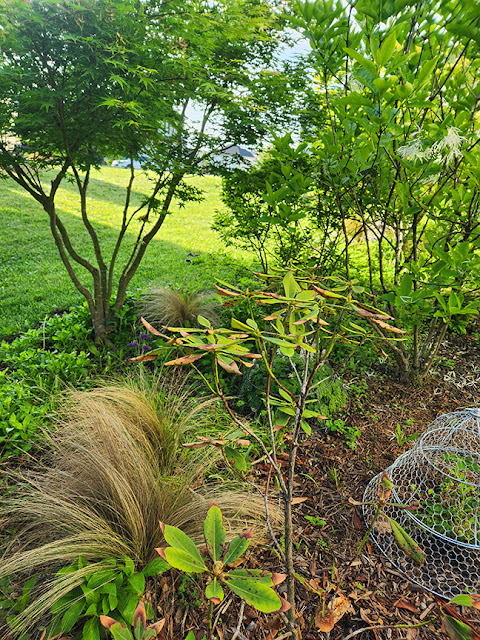 |
Pale Dutch Iris
|
As April turns into May, the progression of spring flowers in my garden begins to peak. Right now the pale Dutch iris are coming into bloom, their perky blossoms brightening the front garden. The bearded irises in this bed (mostly yellow) are ready to burst into bloom, along with the flowering onions (Alliums)
 |
Dutch and bearded iris with giant alliums.
|
 |
Bearded iris 'Blatant' with Dutch iris.
|
My azalea 'General Semmes' is blooming profusely in the shade of the cherry tree in front of the house. The native flame azalea, in an identical pot just a few feet away, had all its flower buds eaten by deer during the winter, but they never touched 'General Semmes.' Why, I can only guess--one is a native and the other a hybrid, perhaps this influences the way it tastes to deer? The Lewisia "Little Peach" growing in a pot in front is lovely too.
 |
Azalea 'General Semmes'
|
 |
Lewisia 'Little Peach'
|
Going along the west of the house, I found a few sprays of lilies of the valley under the maple tree. Although they're supposed to be poisonous, deer do eat these, so only the flowers under a wire cloche survive.
The circle of Spanish Bluebells (Hyacinthoides) under the Zelkova is blooming, but as usual, the deer eat the foliage before the flowers emerge, and often dig up the bulbs as well, making for a less than stellar display. I wish I could find a physical barrier to keep the deer away from this bed... all of my beds!--spraying with deer repellent works only for a very short time.
 |
Lilies of the valley (Convallaria majalis)
|
 |
Spanish Bluebells under the Zelkova tree (Hyacinthoides hispanica)
|
The Clematis vine climbing up to the deck is offering its dainty pink flowers. It looks wonderful from the deck, draping itself over the railing.
 |
Clematis montana 'Appleblossom'
|
My lilac 'Purple Bloomerang' is in full bloom, but the other lilac (behind the purple) has only a few panicles of white flowers.
 |
Lilac 'Bloomerang'
|
More 'Blatant' irises are blooming in the long bed in back--they seem to have recovered from the attack of two years ago. The two prune-leaf Viburnums way in the back near the woods are covered with flowers.
 |
Iris 'Blatant'
|
 |
Pruneleaf Viburnum in bloom.
|
A happy surprise in that part of the yard: the buckeye tree that I grew from seed collected from a hybrid at Blandy is offering its first spike of flowers. From the looks of these, this is likely the Ohio buckeye (Aesculus glabra) rather than the red buckeye (Aesculus pavia) parent. My tree is still quite small--under three feet tall, and must be protected from the deer until it reaches sufficient height to be out of their browsing level.
 |
Flowering spike of buckeye tree.
|
Ambling back towards the house, my Rhododendron 'Southgate Brandi' is blooming nicely under the Japanese maple 'Bloodgood.' I love the pink-tinted new foliage of the full-moon Japanese maple (Acer 'Shirawasanum') and its curious flowers. My Japanese maples suffered a lot of die-back with last year's drought, and I'm hoping they will recover some during this growing season.
 |
Rhododendron 'Southgate Brandi'
|
 |
Japanese maples and fringe tree.
|
Soon the 'Blue Barlow' Columbines and the Virginia fringe tree (Chionanthus virginica) in the east bed will be bursting into bloom. This is always a stunning combination, along with the maples and the pagoda dogwood. This spring I joined the two strips of flowerbed into one, but I haven't had a chance to improve the soil and plant some new spring ephemerals yet. I hope to eventually turn this bed into a small wooded area with shade-loving plants underneath. It's evolved so much from its first year, when all I had planted were the full moon maple and the Carolina Silverbell tree.
 |
East bed expansion with pagoda dogwood on the left.
|
 |
Foam flower (Tiarella cordifolia) under the maples.
|
There's so much work to do at this time of the year for gardeners! Trying to re-plant all the plants that had to be dug up for the veggie garden enclosure, re-edge some beds and get some vegetables in the raised beds is probably more than I can manage in the next week or so. Happy spring!
























































